Texas Railroad History - Tower 170 - Conroe
A Crossing of the International and Great Northern Railroad and the Gulf,
Colorado & Santa Fe Railway
 |
Left:
R. J. McKay took this photo of the Conroe Union Depot on February 1,
1981. R.J.'s timing was fortuitous; the
depot reportedly burned down later that year. It sat in the northwest
quadrant of what originally was a crossing of the International & Great
Northern and Gulf, Colorado & Santa Fe railroads. Long before 1981, both
railroads had been acquired by larger systems, specifically the Missouri Pacific
(1925) and the Atchison, Topeka &
Santa Fe (1887), and both were eventually merged into their parent
railroads (in 1956 and 1965, respectively.) In R.J.'s photo, the Santa Fe tracks cross horizontally
(east/west) and the Missouri Pacific tracks extend
northward toward the horizon.
The presence of the Tower 170
interlocking plant is indicated by the white placard atop the equipment cabinet. In 1959, the interlocker was converted to an
automatic plant, with manual override controls located in the small box
mounted on the short post near the tracks to the right of the cabinet.
Such controls were common for simple interlocked crossings and
were typically mounted on a post (e.g. Tower 70)
or on the side of an interlocker cabin or equipment
cabinet (e.g. Tower 127.)
The Tower
170 interlocker was originally placed in service with a mechanical plant on November 17, 1931. The Annual
Report of the Railroad Commission of Texas issued only six weeks later
mistakenly listed Tower 170 with 70 functions, a huge number, perhaps a
typeset error related to the tower number ending in '70'. Other
sources confirm that Conroe had a 12-function interlocker, the standard
size for a crossing of this nature. |
The International & Great Northern (I&GN) Railroad was
the combination of two unrelated railroads, the International Railroad and the
Houston & Great Northern (H&GN) Railroad. The earliest of these, the H&GN, was
chartered in 1866 by Houston interests with a plan to build north to the Red
River. Construction was delayed for several years; major New York banks were
reluctant to lend money to a new Texas railroad during the initial
Reconstruction period after the Civil War. Work finally began in
December, 1870, and by May, 1873, the tracks had reached Palestine, 151 miles north of
Houston, passing through dense forests of east
Texas along the way. The H&GN's arrival into Palestine
marked the third construction team to do so in less than a year! The
other two were crews of the International Railroad building into Palestine from
opposite directions.
The International had been chartered by investors
to build a line from Texarkana to Laredo; the
northern endpoint was changed to Longview when the Texas & Pacific completed
tracks between Longview and Texarkana. Even before the H&GN reached Palestine, the
management of the International had begun to recognize the potential value in a combined railroad that would
serve Houston, Austin, San Antonio and Laredo, with favorable
connections to Galveston
and Texarkana. An agreement was reached in December, 1872, and the two
railroads began operating under a combined management structure led by Herbert
Melville "Hub" Hoxie as General Superintendent of both railroads. The
International's offices were moved from Hearne to
Houston so that Hoxie could run both railroads while awaiting legal permission
to merge. Two years later in March, 1875, the Legislature authorized the new
railroad, the International & Great Northern (I&GN).
A portion of the H&GN's
construction had passed through the center of Montgomery County, about 35 miles
north of Houston. The county had been organized in 1837 under the laws of the
Republic of Texas, with the tiny community of Montgomery named as the
county seat. Montgomery's population had reached approximately 400 persons by
1877 when local investors decided to bring a railroad to town. To do so, they
filed for a new railroad charter, the Central & Montgomery (C&M) Railway, with plans to build
a 25-mile rail line between Montgomery and
Navasota. The line was completed
in 1878, and a connection was made at Navasota to the Houston & Texas Central
(H&TC) Railway. The H&TC was the major north/south line
in Texas at the time, and its service to Houston
would be handy for citizens of Montgomery County. If getting to Houston
had been the only consideration, it would have been shorter to build 18 miles
east from Montgomery to reach the I&GN tracks. At the time, however, there was
no community and little population along the I&GN east of Montgomery whereas
Navasota had a population over 1,500 that would help
generate commerce upon which the C&M would depend.
In 1882, the C&M was sold to
the Gulf, Colorado and Santa Fe (GC&SF) Railway led by its President George
Sealy. The GC&SF main line
ran from Galveston to
Temple, with a main line branch from there to Ft.
Worth and another proceeding northwest from Temple, ostensibly toward the Texas Panhandle.
Unfortunately for Sealy, the GC&SF's purchase of the C&M was rejected in legal
proceedings. S. G. Reed, in his book A History of the
Texas Railroads (St. Clair Publishing, 1941) explains...
The Supreme Court of Texas
afterwards decided that on account of certain defects in its charter power, the
G. C. & S. F. had not acquired good title to the property. This necessitated
foreclosure and sale on September 6, 1887, at which the Santa Fe bought the road
direct for $70,500 and secured a deed to the property from the Sheriff who was
paid $17,277.19 in cash and given the receipt of George Sealy, who was the sole
stockholder of the C.& M. R. R., the bonds having been extinguished. In the
meantime the Legislature on March 27, 1887, ratified and confirmed the original
sale. The Santa Fe, however, did not let these legal technicalities stop its
march toward the timber of East Texas.
 |
The C&M was acquired to be
part of a route to
the Gulf port of
Beaumont that the GC&SF was planning to build to
serve east Texas
lumber shipping. Work began in 1883 with construction of 29 miles from the GC&SF
main line at Somerville eastward to the western
terminus of C&M's rails at Navasota. From Montgomery at the east end of the C&M,
the GC&SF resumed building eastward in 1885, completing 18 miles to the
community of Conroe where its rails crossed the I&GN.
Left:
The Taylor County News
(Abilene), May 1, 1885
Right:
Galveston Daily News, June 22,
1885, quoting the Huntsville Item,
suggesting that it's always good to escape the "slough of despond." |
 |
| Conroe was named for Capt. Isaac Conroe, a Montgomery County
sawmill owner. On timber land purchased from J. G. Smith, Conroe built a new sawmill
in 1881 a dozen
miles north of his previous sawmill and two and half miles east of
the I&GN tracks. He then built a planing mill near the I&GN tracks
to finish the rough lumber produced at the main mill. To connect the two mills, Conroe built a
mule-drawn tram with wooden rails. The I&GN installed switches and
sidings to support transferring the finished lumber from the planing
mill into railcars. In 1882, shortly after
Conroe built his tram, the GC&SF bought land and a right-of-way through
the area for eventual use in its plan to build to Beaumont. In 1885, the
GC&SF crossed the I&GN near the siding switch for the planing mill and paralleled the tram
all the way to Conroe's main mill. |
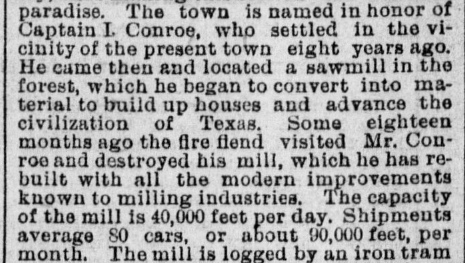
from the Galveston Daily News,
December 9, 1889 |
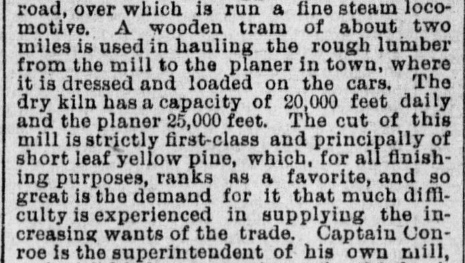 |
By the time the GC&SF built across the I&GN in 1885, Isaac Conroe had
already established mail service for his town. Conroe had requested (by
mail or telegram) a form from the Post Office Department as the first
step. In response, the top part of
the form (right) was filled out on November 12, 1883 by
officials in Washington, D.C. (who mistakenly listed "Willis" as the
county.) The form was sent to Isaac Conroe via the Postmaster at
Willis, a settlement with mail service eight miles north of Conroe's
mill. Conroe filled out the portion below "STATEMENT" with information about the location and population of
his community (viewable on the full
form.) He
signed and mailed it to the Post Office Department on November 19, 1883,
which stamped its receipt on November 24, 1883. Conroe's post office was to be
located 200 ft. from the I&GN tracks. (courtesy National
Archives, from microfilm)
The original name of the town was
reportedly Conroe's Switch,
shortened to Conroe's and then supposedly shortened again to
Conroe in 1889 by the Post Office. The document
at right, however, shows that as of November, 1883, Conroe was the name
of the "proposed office" filled in by Isaac Conroe and maintained in
subsequent Post Office records. There are newspaper citations to Conroe's and Conroe's Switch
suggesting that these names were in common use, at least in the early years.
In 1923, Will Conroe, son of
Isaac Conroe, published an article in the
Conroe Courier titled "How Conroe Got Its Name" wherein he
explained that his father had chosen to raise the family in Houston,
commuting regularly to his mill via the I&GN. The mill was not a station
on the I&GN but Conroe had developed a way of flagging trains to stop.
During a chance meeting on the train, Conroe and I&GN General
Superintendent Hub Hoxie discussed having the I&GN add a station at
the planing mill. Hoxie suggested the station be named Conroe's Switch.
In April, 1889, the town of Conroe won an election to become the new
county seat of Montgomery County, a seat it has held continuously since
then.
|
 |

Above:
Railway Age, January 1, 1892 |
In 1887, the Atchison, Topeka & Santa Fe (AT&SF) Railway, a large Plains and
Midwest railroad, acquired the GC&SF. Although this was a "friendly"
acquisition negotiated by George Sealy, it required the GC&SF to complete three major construction projects in 1886. This work
shifted the entire focus of the GC&SF away from its line to east Texas,
which remained stopped at Conroe's mill for
several years. During that time, the Texas, Louisiana and Eastern (TL&E) was
chartered in 1891 by Conroe interests to build east
to the Trinity River. Construction began at Conroe's
mill, a location the TL&E named Beach for its chief engineer,
W. C. Beach. The TL&E went into receivership in 1894 and was acquired by
the GC&SF in 1897 as Santa Fe resumed its push eastward, deeper into the
Texas pine forests. The AT&SF merged with Burlington Northern in 1996 to
form Burlington Northern Santa Fe (BNSF), which continues to operate the
former GC&SF tracks through Conroe. |
The I&GN was acquired by rail baron Jay Gould in 1880.
After his death in 1892, his son George ran it for the next 25 years. During
that time, it went into receivership twice. The 1914 receivership lasted until
1922 when the reorganized railroad company, free of the Gould family, took a new
name, becoming simply the International - Great Northern (I-GN) Railroad. Its
large presence in Texas and its recurring financial issues made it a candidate
for takeover by a larger railroad. Missouri Pacific (MP) tried to buy the I-GN
in 1924 as a means of gaining access to the Texas market, but the Interstate
Commerce Commission (ICC) nixed the sale. MP, however, had a fallback strategy
that involved the New Orleans, Texas & Mexico (NOT&M) Railway. The NOT&M had
been founded in 1916 to be the independent "holding railroad" for three Gulf
Coast railroads and several smaller ones that operated collectively as the Gulf
Coast Lines (GCL). These were properties formerly controlled by the St. Louis &
San Francisco Railway before its receivership in 1914. MP convinced the NOT&M to
buy the I-GN; the ICC approved the sale in June, 1924. MP followed up by
proposing to buy the entire NOT&M, a sale approved by the ICC and consummated on
January 1, 1925. The I-GN continued to operate under its name until 1956 when it
was operationally consolidated (along with the
GCL railroads) into MP. MP was acquired by Union Pacific (UP) in 1982 and
became fully integrated into UP operations in 1997. UP continues to operate the
former I-GN tracks through Conroe.
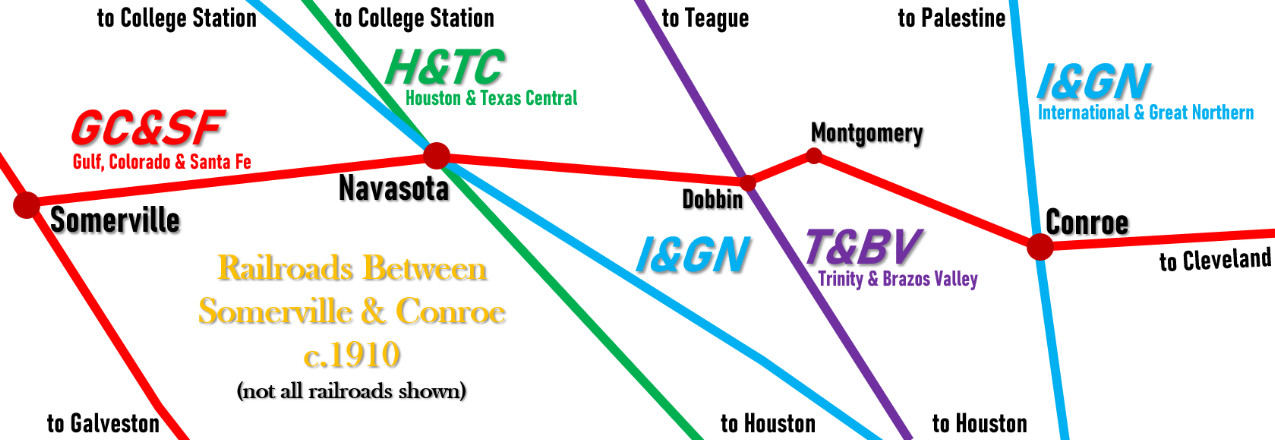
The crossing of the two railroads at Conroe remained officially uncontrolled
through 1930. At least initially, all trains were required to stop before proceeding across the diamond.
Regulations issued by the
Railroad Commission of Texas (RCT) mandated swing gates at uncontrolled
crossings, and eventually, trains were permitted to approach swing gate crossings at
restricted speed, continuing without stopping if the gate was visually observed
"open". The requirement for swing gates was not rigorously enforced,
and it is undetermined whether a swing gate was ever installed at Conroe.
Sometimes, a depot's proximity to the crossing caused virtually all trains to stop anyway, so a gate
was not needed. As higher efficiency steam locomotives allowed freight and
express passenger trains to
bypass stops (e.g. for water or passengers) that were operationally unnecessary, the need for a gate might become
more evident despite the presence of a nearby depot or water tank. By 1931, Conroe had arguably
become a crossing of two main lines.
Santa Fe's "branch" to east Texas had taken on a life of its own as the tracks were
extended farther east and subsequently, by acquisition, north to Longview and
south to Beaumont.
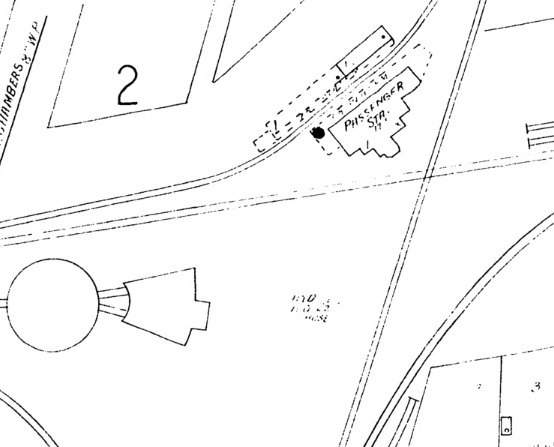 |
RCT's Annual Report issued at the end of 1931 (below) identified
Tower 170 as a 70-function (!) mechanical
plant commissioned on November 17, 1931. This was a mistake as
Conroe was nowhere near the tenth largest interlocking in Texas (...nor was
Tower 169 in Bay City a 66-function plant!
- another inexplicable mistake.)

In the January, 1932 issue of Railway Age, a table of
Interlocking Plants Completed During 1931
lists
Conroe with a 12-function mechanical plant. This was the standard for a simple crossing
of two railroads, consisting of a home signal, a distant signal and a
derail in each of the four directions.
Left: The 1938 Sanborn
Fire Insurance Map of Conroe
shows
no trackside cabin near the diamond; the interlocker controls were
undoubtedly located inside the depot. Note connecting tracks in
three of the four quadrants, and the Santa Fe turntable and engine house
in the southwest quadrant. The Tower 170 interlocker was
rebuilt in 1946 with six signals and three control levers (per
Railway Signaling, January, 1947),
and then converted to an automatic plant in 1959 (below).
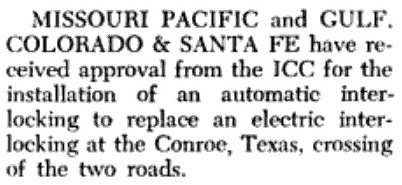
Railway Signaling and Communications,
January, 1959 |
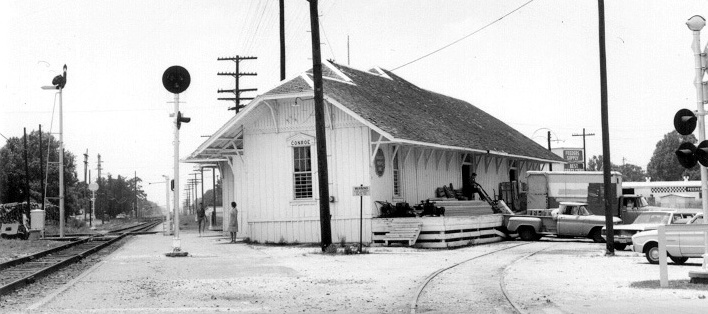
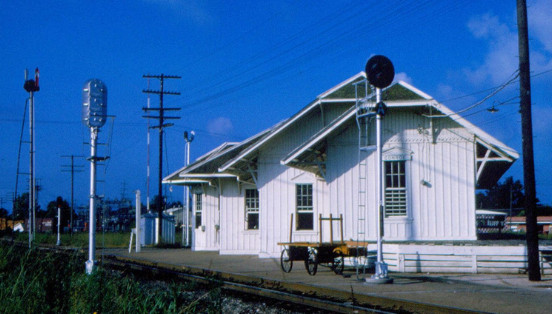
Above Left: undated photo looking south (DeGolyer
Library, Southern Methodist University, hat tip, Myron Malone)
Above Right: Conroe depot in
1964 (Montgomery County Historical Comm.)
Below Left: A southbound MP caboose crosses the diamond in 1975
(Chino Chapa collection) Below Right:
undated photo looking north (Missouri Pacific Historical Society)

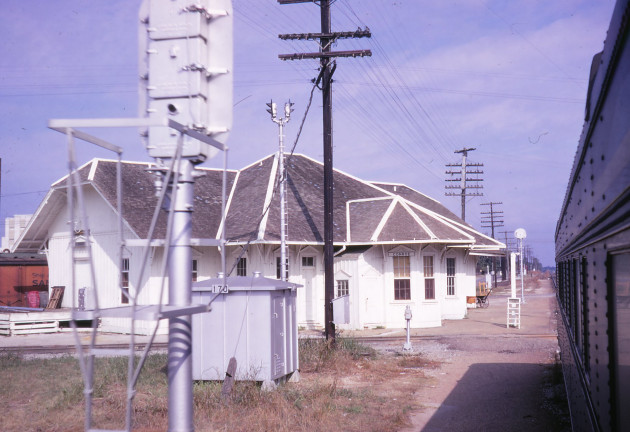
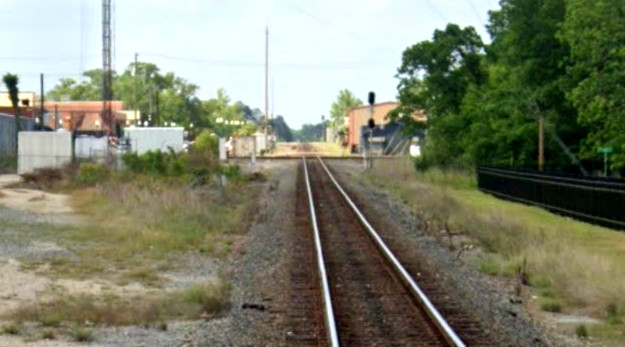
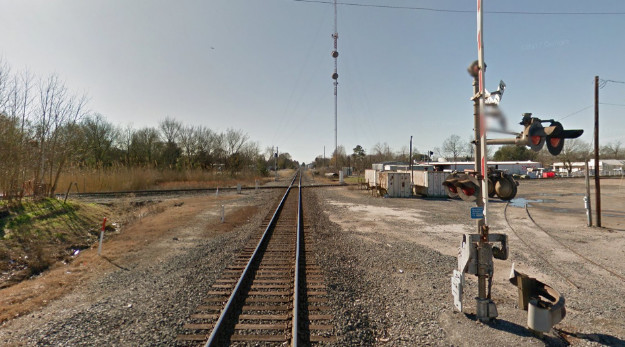
Four views of the Tower 170 crossing from Google Street View (clockwise from
above left: facing North, South,
East, West) There are no longer any active connecting tracks.
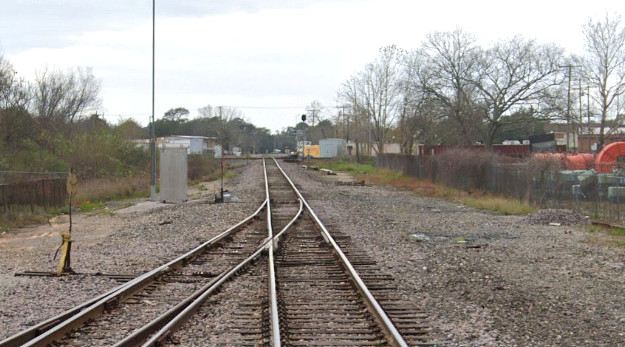
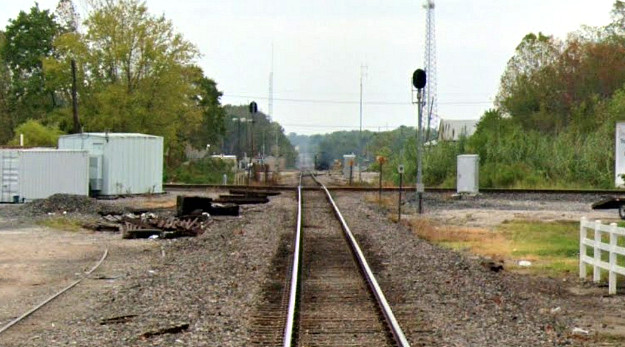
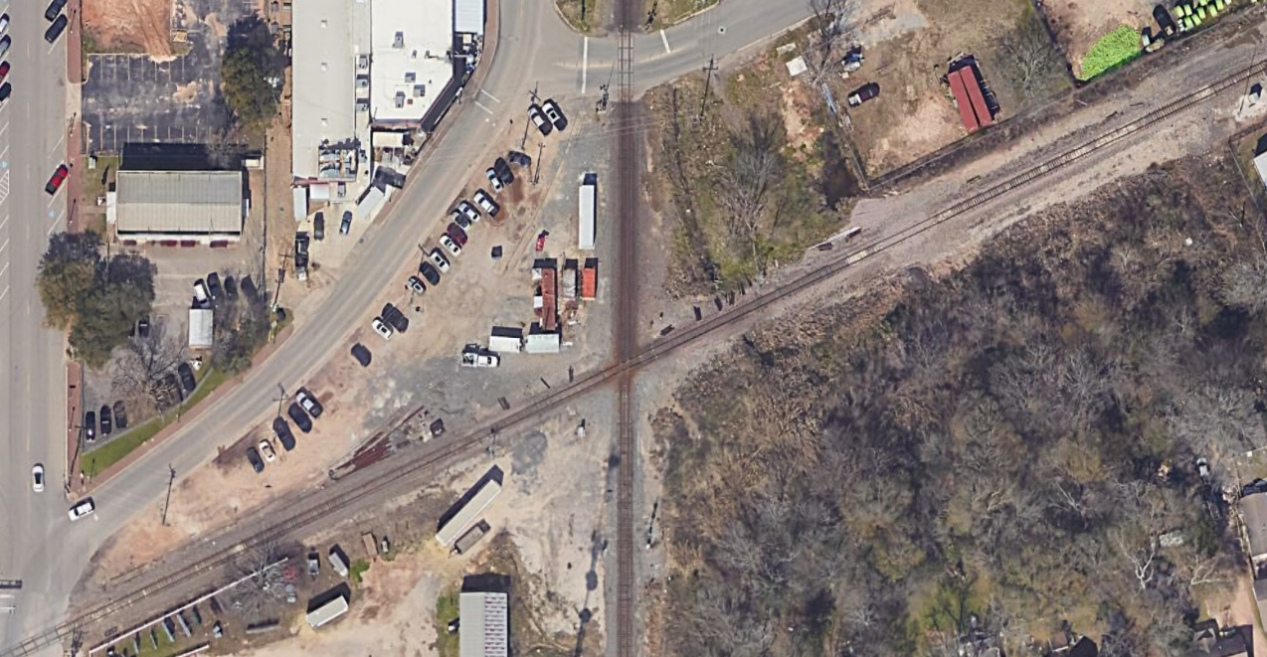
Above:
February 2023 Google Earth view of the Conroe crossing


















